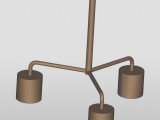Lamps have a great influence on the development of human civilization. On the one hand, modern lighting design is more and more advocating style, and the role of lamps is not limited to lighting, but also has a small auxiliary role in the decoration of houses; on the other hand, the work of lamps The heat generated in the process has an effect on the lighting effect. Therefore, the design and structural optimization of the luminaires have always been the research direction of the entire lighting industry.
In the past, the finite element method for high-power LED lamps mostly focused on structural analysis and thermal analysis modules. The finite element method can solve the structural vibration, fatigue and heat dissipation problems in the design process, thus shortening the development cycle and site of new products. Test cost. It can be said that the role of CAE technology in the lighting industry is very important.
Compared with high-power LED lamps, general lighting fixtures also occupy a large part of the whole industry. For example, lighting systems in public places mainly focus on lighting, so there is no higher requirement in the decorative aesthetics. The design of such luminaires only needs to consider their own gravity. Simright Simulator can simulate its own gravity acceleration load. The ordinary three-head chandelier shown in the figure below is made of alloy and installed indoors without considering wind load and other factors.

Import the model into the Simulator, assign the material properties, apply a fixed surface constraint on the top of the chandelier, apply its own gravity acceleration, divide the mesh and submit the solution. After the solution is completed, the post-processing interface is automatically popped up, and the displacement cloud map and the stress cloud map are selected, as shown in the following figure.


It can be seen from the displacement cloud diagram that the maximum displacement occurs at the bottom of the chandelier, indicating that the chandelier is easily bent due to its own weight after installation. Therefore, the branch rod should be selected as a rigid material; from the stress cloud diagram, it can be seen that the stress is concentrated on the chandelier main pole and branch. The rod joint is the most prone to breakage at this point. In the design of the luminaire, it should first consider whether the allowable stress of the joint material meets the actual demand.
Click to view item


